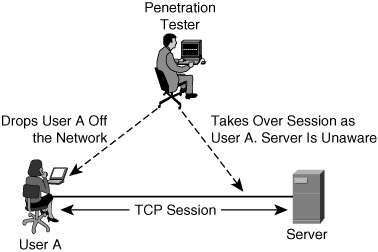Step-by-Step Plan
| < Day Day Up > |
| Every good penetration test involves the following steps:
Chapter 5, "Performing Host Reconnaissance," addresses the reconnaissance step. The last four steps, which are typically done in sequence, are covered in the remaining chapters. Before you can perform the first step, however, you and the client (or management, if you are doing an internal test) must do the following:
Defining the ScopePenetration testing is a lot like a pirate looking for buried treasure. The pirate does not know exactly where the buried treasure is, but he knows it is valuable enough to go looking for it. A pirate has a treasure map full of clues all geared to direct him toward the buried treasure. In the same way, penetration testers are on a quest to infiltrate a client network. The testers do not know in advance how they are to go about infiltrating the network, but in the end, the results of the test have to be worthwhile to the client. If a client is most concerned with the security of their Internet presence, then you should not devote your time to trying to break into the internal network. Likewise, if the client is concerned only about the security of his accounting department, it does not make sense to devote your time to other departments. The first step, then, is to narrow the scope of your test to what is meaningful to the client. Ask the client what he hopes to achieve through this testing. Perhaps he only wants to assess whether he is vulnerable to having account information stolen, or the scope might extend to any type of attack. Ideally, all possible means of attacks should be allowed to provide the most realistic scenario of a real malicious attack, but this is seldom the case. Budget constraints, concerns over denial of service (DoS) attacks disrupting daily information, and the protection of employee privacy are often deterrents that prevent organizations from authorizing all forms of attacks. Social EngineeringSocial engineering, described in more detail in Chapter 4, "Performing Social Engineering," is the process of human-based manipulation to achieve access. Some organizations permit the use of social engineering, and some do not. You need to discuss this with the client (and have it in writing) before you begin testing. Session HijackingSession hijacking, described in more detail in Chapter 6, "Understanding and Attempting Session Hijacking," is the process of taking over a TCP session between two machines to gain access to an unauthorized system, as illustrated in Figure 3-1. Figure 3-1. Session Hijacking In Figure 3-1, the penetration tester is listening to network traffic being sent from User A to the server. The penetration tester takes over the session and appears to the server as that user. To make this work, the penetration tester has to drop User A off the network (usually through sending a TCP reset packet). This can be disruptive to day-to-day operations and it is often not permissible to perform these tests. An alternative is to create a lab environment that contains equivalent network equipment. Trojan/BackdoorAnother factor requiring authorization before performing tests is whether the use of Trojans or other backdoor software is to be allowed. Encourage the client to allow this. Many of the more cunning attacks use backdoor applications and Trojans. If you want to have accurate results, you need authorization to use these applications. If you do agree on the use of Trojan applications and other backdoor applications, be careful about what tools you use. Some websites give you the option of downloading Trojan and backdoor tools such as Netcat, but they contain their own virus embedded in the program. These viruses, when put on a client machine, can propagate throughout the network, causing havoc on servers and end user computers. |
| < Day Day Up > |
EAN: 2147483647
Pages: 209
